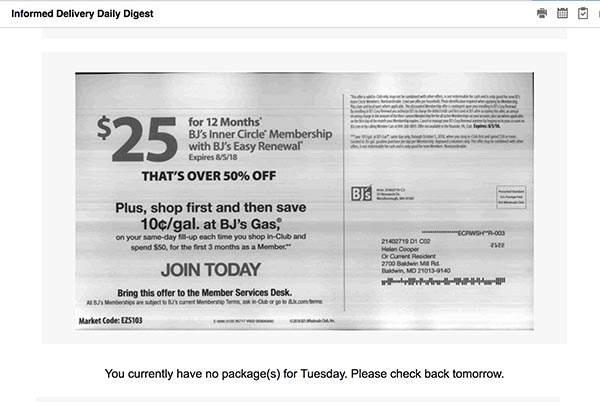I had a funny this happen to me this morning. The USPS’s Informed Delivery Service changed my schedule. It also changed how I prioritized one retailer over another. It did exactly what the USPS hoped it would do, and if I’m right, over time, it will change how marketers design their mail.
This was my first personal experience with Informed Delivery. I’d signed up before—probably a year ago now—and the process was buggy. Even though I’d signed up, I never did start receiving the digital images. Then we sold the house. During the online address forwarding process, I had the opportunity to sign up for Informed Delivery again—this time by simply checking a box.
The USPS must have worked out the bugs, because the day after the forwarding date, I began receiving notifications. Over the next two days, three fascinating things happened.
- Informed Delivery changed how I arranged my day. On the first day, I opened my “daily digest” and saw that there would be a piece of mail arriving that I’d been waiting for. Our mail comes in the middle of the day, so I planned my day around being home when it arrived.
- It changed how I sorted the mail. On day two, I opened my daily digest and saw primarily marketing offers. Details of three out of the four had been printed on the outsides of the envelopes, so they were visible in the preview. “Shop and save $10.” “Up to $500 credit to get out of your contract.” “$25 for 12 months.” Before I had finished my first cup of coffee, I knew which offers would be relevant to me and which would not. When the physical mail arrived, I went right to the pieces I was interested in and recycled the rest.
- It changed where I shopped that day. The impact of the “Shop and Save $10“ offer was particularly interesting. We love to upcycle furniture, and we buy a lot of supplies (paint, sealer, brushes, sandpaper). When we need something, the quickest and easiest thing to do is run to the hardware store on the corner, and sometimes we do. However, it’s more expensive, so most of the time, we drive nine miles away to the big box retailer and buy in bulk. This time, knowing that a coupon was on its way, instead of finding an excuse to drive into town (“We need eggs and bread anyway”), I waited.
Several months ago, I put the question out there: Could Informed Delivery actually change mail over time? Could it cause marketers to prioritize postcards, where the offer is fully visible in the digital preview, or the use of on-envelope messaging? Could it change how marketers engage with consumers and influence consumers’ relationships with marketers? As the percentage of Americans signed up for Informed Delivery grows, I think we can only expect that it will.
The only data I can find on the number of Informed Delivery accounts is from October 2017. At the time, the number of people with active accounts was 8.1 million, up 28% over a period of five months. Assuming the same rate of growth, we would expect the number of accounts to be around 11.5 million today. Now we’re getting into numbers that change not only broader consumer behavior, but marketer behavior, too.
What is your experience? What impact do you see Informed Delivery having?











Discussion
By Tim Daisy on Jul 31, 2018
I’ve been using informed delivery for over a year. I have a P.O. Box which is a two mile walk/bike/drive away. Knowing what’s in my box dictates if and when I go to the post office. Graphics on the envelope certainly help me determine the contents of the envelope at a glance. If those graphics are personalized, it’s even easier and more compelling.
I’m hoping some day informed delivery will include magazines. I may skip a visit to the post office when I actually have received this week’s Time or this month’s National Geographic.
Informed Delivery is definitely a game changer for me!
By Gina Danner on Jul 31, 2018
It is a great service. I use to just go to my collection box once a week, now I will stop by 2-4 times a week when I know what is there.
When I talk about the tool to clients (all marketers) they get it from a marketing perspective -- if nothing else it is another high value brand impression.
But, the cool thing is when people start relying on it. The daily digests have north of an 80% open rate. That's pretty amazing. And, our clients are seeing a 1-3% click rate on the ride along image.
I am however, constantly amazed, at major mailers that are not using the high value enhanced informed delivery aspect of the program.
By Kurt Ruppel on Jul 31, 2018
Heidi - Your projection on the number of Informed Delivery (ID) subscribers is really accurate. At last week's Western Area AIM meeting in Minneapolis, USPS VP Innovation Gary Reblin shared that as of July 16, ID had 11.2 million subscribers.
Gina - We expect to see more mailers take advantage of the enhanced aspect of the program as the number of subscribers continues to grow.
By Pete Basiliere on Aug 03, 2018
I have a couple of questions that I hope one of you can answer:
1) While the recipient can only see the images for seven days, how long does the USPS keep its digital copies of the mailpiece front/back images?
2) Does the USPS provide those images to law enforcement?
3) If so, does the USPS provide those images only when served with a subpoena?
Discussion
Join the discussion Sign In or Become a Member, doing so is simple and free